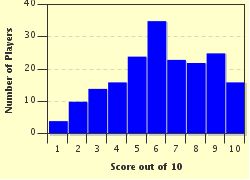Quiz Answer Key and Fun Facts
1. This condition is characterized by an accumulation of thick mucus in multiple organs including the lungs and pancreas. People with the condition often have chronic respiratory disease and digestive problems. What disease is this?
2. A pregnant woman has her fetal anatomy ultrasound at 20 weeks gestation, and her doctor tells her that her baby's arms and legs are shorter than expected. The femur and humerus measure less than the fifth percentile. Other ultrasound findings include a narrow thorax, a large head with a pronounced forehead, and hydrocephalus (increased fluid in the brain). What condition should the doctor inform the patient that her baby may have?
3. Jordan, a 14-year-old male visits his doctor for a physical exam that is required by the basketball team prior to try outs. The basketball coach told Jordan he could be a great asset to the team because of his tall height. Jordan is already 6 foot 6 inches. In the medical history, the doctor learns that Jordan was diagnosed with dislocated lens of the eyes in the past year. During the physical exam, Jordan is noted to have unusually long fingers and a long arm span. He also has pectus excavatum (sunken chest). The doctor is suspicious of genetic disorder and sends him to a cardiologist who finds that Jordan has an enlarged aorta by echocardiography. What condition was the doctor suspicious of?
4. What condition results in abnormally-shaped red blood cells, which can lead to anemia, fatigue, growth delay, jaundice, pain crises, frequent infections, pulmonary hypertension, and organ damage?
5. A 42-year-old pregnant woman goes in for her 20 week fetal anatomy ultrasound. Multiple major anomalies and soft markers are seen, including a heart defect, cleft lip, clenched hands, club feet, absent radial bones, growth restriction, and a small head size. The woman decides to have an amniocentesis. Fetal chromosome analysis came back abnormal. What condition does the baby most likely have?
6. Common features of this condition are chorea (involuntary movements and jerks), poor coordination, impaired judgement, depression, and cognitive decline. Symptoms typically begin in a person's thirties or forties with death occurring 15 to 20 years after onset. Pathologically, there is an accumulation of abnormal protein in neurons, resulting in neuronal death in areas of the brain. What condition best fits with this description?
7. Alexis, a 38-year-old woman, was referred to a gastroenterologist because of abdominal pain, malaise, and rectal bleeding. A colonoscopy was performed, and three colon polyps were removed from the right side of the colon. The polyps were biopsied and found to be benign but with the potential of becoming cancerous. The doctor obtained a family history. Alexis' mother was diagnosed with endometrial cancer at 55, her maternal uncle was diagnosed with colon cancer at 51, and her maternal grandfather died of stomach cancer at 63. With this information, what condition should be in the differential diagnosis?
8. A pregnant woman receives her 20 week fetal anatomy ultrasound, which shows abnormal findings of the baby's skeleton. Multiple broken bones, limb shortening, and bowing of the bones are seen. Which condition should be included in the differential diagnosis?
9. Kevin is a 11-year-old boy with progressive muscle weakness. His birth and newborn period were uncomplicated. In late infancy, Kevin started missing developmental milestones. His motor skills (sitting, standing, walking) were delayed. Symptoms critical to Kevin's diagnosis were calf enlargement, toe walking, and the Gowers' sign (a movement to standup where the child first places arms and knees on the ground and then moves the hands up the legs until an upright position is reached). What condition does Kevin most likely have?
10. Jessica gave birth to a seemingly healthy baby girl Angela, but she just received the news that Angela's newborn screening results came back abnormal. Jessica attends an appointment with a medical geneticist who informs Jessica that Angela's condition can be treated with a strict diet low in protein. If untreated, Angela will likely develop permanent intellectual disability, epilepsy, and behavioral problems. Of the following choices, what condition has Angela been newly diagnosed with?
Source: Author
jbogacik
This quiz was reviewed by FunTrivia editor
WesleyCrusher before going online.
Any errors found in FunTrivia content are routinely corrected through our feedback system.


